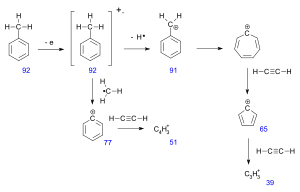User:Anabat1/sandbox
 | This is a user sandbox of Anabat1. A user sandbox is a subpage of the user's user page. It serves as a testing spot and page development space for the user and is not an encyclopedia article. |

In mass spectrometry, fragmentation is the dissociation of energetically unstable molecular ions formed from passing the molecules in the ionization chamber of a mass spectrometer. The fragments of a molecule cause a pattern in the mass spectrum used to determine structural information of the molecule. [1]
Mass Spectrometry Techniques
[edit]Fragmentation of a molecule can take place by a process of heterolysis or homolysis.
It can occur in the ion source (in-source fragmentation) where it is generally not a desired effect. Ion source conformation is an important criterium in the level of fragmentation observed.
Desired fragmentation is made in the collision zone (post-source fragmentation) of a tandem mass spectrometer. It is a part of gas phase ion chemistry and there are different types of mass fragmentation:
- collision-induced dissociation (CID),
- electron-capture dissociation (ECD),
- electron-transfer dissociation (ETD),
- negative electron-transfer dissociation (NETD),
- electron-detachment dissociation (EDD),
- photodissociation, particularly infrared multiphoton dissociation (IRMPD) and blackbody infrared radiative dissociation (BIRD),
- surface-induced dissociation (SID),
- Higher-energy C-trap dissociation (HCD),
- charge remote fragmentation.
Fragmentation Reactions
[edit]Fragmentation of a molecule can take place by a process of heterolysis or homolysis. The certain structures favour fragmentation the α-cleavage and the McLafferty rearrangement are two examples for the often observed fragmentations.
Other schemes includes Heterocyclic ring fission (HRF), benzofuran forming fission (BFF), quinone methide (QM) fission or Retro Diels-Alder (RDA).[2]
Sigma Bond Cleavage
[edit]Sigma bond cleavage is most commonly observed in alkanes. This occurs when an alpha electron is removed. The C-C bond elongates and weakens causing fragmentation. Fragmentation at this site produces a charged and a neutral fragment.
Radical Site-Initiated Cleavage
[edit]Charge Site-Initiated Cleavage
[edit]Rearrangements
[edit]Functional Groups
[edit]xxxx
See also
[edit]References
[edit]- ^ Fred W. McLafferty (1 January 1993). Interpretation of Mass Spectra. University Science Books. ISBN 978-0-935702-25-5.
- ^ Tandem Mass Spectrometry for Sequencing Proanthocyanidins. Hui-Jing Li and Max L. Deinzer, Anal. Chem., 2007, volume 79, pages 1739-1748, doi:10.1021/ac061823v
External links
[edit]Category:Tandem mass spectrometry
